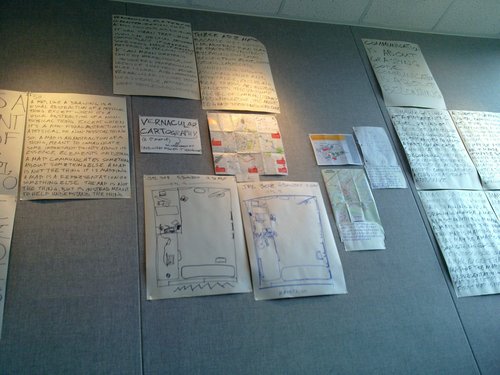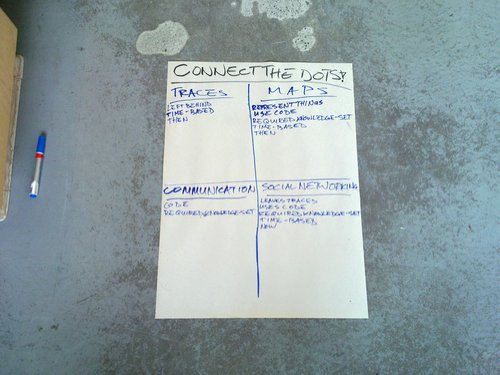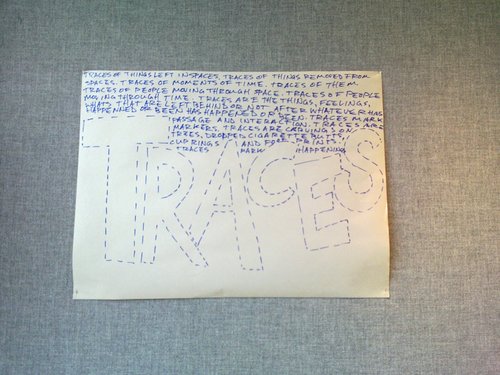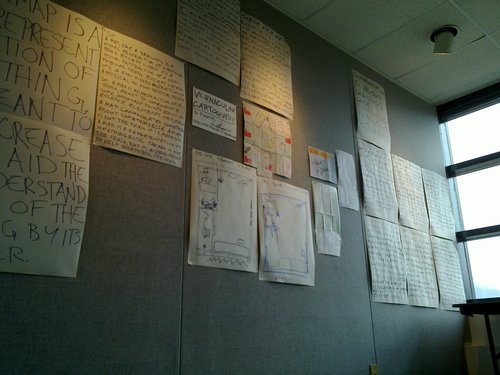I'm at the Banff Centre, doing a residency. It's called Almost Perfect and is an opportunity to kick around in the mountains for a month, thinking big thoughts about locative media and eventually, producing something. So I've been futzing around, thinking about vernacular cartography, communication, traces and pervasive sociability. I've been pacing around my studio, staring out at the Rocky Mountains. There've been some pretty killer conversations, too. Basically, I've been defining things and mapping things. Below, some pictures of the process taking place on the walls of my studio, as well as transcriptions of that process.

Maps
A map, like a drawing, is a visual abstraction of a physical thing. Except when it's a visual abstraction of a non-physical thing. Except when it's a non-visual abstraction of a physical or non-physical thing. So: A map is an abstraction of a thing, meant to communicate some important points about its essence, elements or details. A map communicates something about something else. A map is not the thing it is mapping. A map is a representation of something else. The map is not the thing, but is instead meant to help understand the thing.

Communication
Communication, at a fundamental level, relies on a level of common literacy and knowledge, on the ability to grasp a particular code. Communication is about belonging. Shorthand code necessitates shared experience and social norms. Communication is a club with a secret handshake.
Maps as communication
A map is a form of communication. A map may be a drawing and a drawing may be a map. Almost anything may be a map, except the thing the map is mapping, although that may be a map of something else. So it is possible to map a map, except that the map of the map is a representation of the first map, but not of what the first map is mapping.
Maps and time
Maps represent moments in time. A map I draw now does not reflect the reality of the space two hours ago or the reality of how it will look in ten minutes. This is a good reason for representing in broad strokes. Fine detail changes too quickly.

Traces
Traces of things left in spaces. Traces of things removed from spaces. Traces of moments of time. Traces of them. Traces of people moving through space. Traces of people moving through time. Traces are the things, feelings, whats that are left behind or not after whatever has happened or been has happened or been. Traces mark passage and interaction. Traces are markers. Traces are carvings on trees, dropped cigarette butts, cup rings and footprints. Traces mark happenings.

The vernacular
Vernacular, as a term or characterization, cuts across concepts and disciplines. It can mean that which is vulgar, or local, or simply commonplace. It can mean something made of available materials, in the local style. It can mean something done by normal people, not considered professional doers of that thing. Vernacular is local and commonplace. Vernacular is what people do as people, instead of what people do as workers.

Maps
A map, like a drawing, is a visual abstraction of a physical thing. Except when it's a visual abstraction of a non-physical thing. Except when it's a non-visual abstraction of a physical or non-physical thing. So: A map is an abstraction of a thing, meant to communicate some important points about its essence, elements or details. A map communicates something about something else. A map is not the thing it is mapping. A map is a representation of something else. The map is not the thing, but is instead meant to help understand the thing.

Communication
Communication, at a fundamental level, relies on a level of common literacy and knowledge, on the ability to grasp a particular code. Communication is about belonging. Shorthand code necessitates shared experience and social norms. Communication is a club with a secret handshake.
Maps as communication
A map is a form of communication. A map may be a drawing and a drawing may be a map. Almost anything may be a map, except the thing the map is mapping, although that may be a map of something else. So it is possible to map a map, except that the map of the map is a representation of the first map, but not of what the first map is mapping.
Maps and time
Maps represent moments in time. A map I draw now does not reflect the reality of the space two hours ago or the reality of how it will look in ten minutes. This is a good reason for representing in broad strokes. Fine detail changes too quickly.

Traces
Traces of things left in spaces. Traces of things removed from spaces. Traces of moments of time. Traces of them. Traces of people moving through space. Traces of people moving through time. Traces are the things, feelings, whats that are left behind or not after whatever has happened or been has happened or been. Traces mark passage and interaction. Traces are markers. Traces are carvings on trees, dropped cigarette butts, cup rings and footprints. Traces mark happenings.

The vernacular
Vernacular, as a term or characterization, cuts across concepts and disciplines. It can mean that which is vulgar, or local, or simply commonplace. It can mean something made of available materials, in the local style. It can mean something done by normal people, not considered professional doers of that thing. Vernacular is local and commonplace. Vernacular is what people do as people, instead of what people do as workers.
Leave a comment